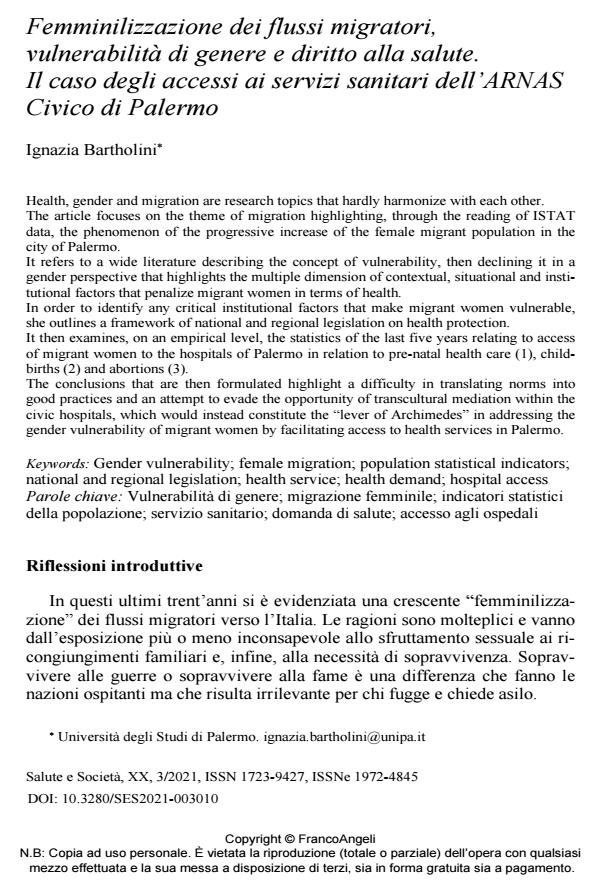Femminilizzazione dei flussi migratori, vulnerabilità di genere e diritto alla salute. Il caso degli accessi ai servizi sanitari dell’ARNAS Civico di Palermo
Journal title SALUTE E SOCIETÀ
Author/s Ignazia Bartholini
Publishing Year 2021 Issue 2021/3 Language Italian
Pages 16 P. 159-174 File size 283 KB
DOI 10.3280/SES2021-003010
DOI is like a bar code for intellectual property: to have more infomation
click here
Below, you can see the article first page
If you want to buy this article in PDF format, you can do it, following the instructions to buy download credits

FrancoAngeli is member of Publishers International Linking Association, Inc (PILA), a not-for-profit association which run the CrossRef service enabling links to and from online scholarly content.
Health, gender and migration are research topics that hardly harmonize with each other. The article focuses on the theme of migration highlighting, through the reading of ISTAT data, the phenomenon of the progressive increase of the female migrant population in the city of Palermo. It refers to a wide literature describing the concept of vulnerability, then declining it in a gender perspective that highlights the multiple dimension of contextual, situational and institutional factors that penalize migrant women in terms of health. In order to identify any critical institutional factors that make migrant women vulnerable, she outlines a framework of national and regional legislation on health protection. It then examines, on an empirical level, the statistics of the last five years relating to access of migrant women to the hospitals of Palermo in relation to pre-natal health care (1), childbirths (2) and abortions (3). The conclusions that are then formulated highlight a difficulty in translating norms into good practices and an attempt to evade the opportunity of transcultural mediation within the civic hospitals, which would instead constitute the "lever of Archimedes" in addressing the gender vulnerability of migrant women by facilitating access to health services in Palermo.
Keywords: Gender vulnerability; female migration; population statistical indicators; national and regional legislation; health service; health demand; hospital access
- UNDOC – UNGIFT (2008). An Introduction to Human Trafficking: Vulnerability, Impact and Action. -- Disponibile in pdf: https://www.unodc.org/documents/ human trafficking/An_Introduction_to_Human_Trafficking_-_Background _ Paper .pdf (26/06/2020).
- Adger N.W. (2006). Vulnerability. Global Environment Change, 16.
- Bartholini I. (2007). Percorsi della devianza e della diversità. Dall’“uomo atavico” al “senza permesso di soggiorno”. Milano: FrancoAngeli.
- Bartholini I. (2019). Professionisti dell’accoglienza in Sicilia. Riflessività e consapevolezza in tema di violenza di prossimità. Sicurezza e Scienze Sociali, VII, 3.
- Bartholini I. (2021a). Il ruolo delle donne nell’accoglienza e nell’inclusione dei migranti. Società-Mutamento-Politica (SMP). Rivista Italiana di Sociologia. 1: 193-204.
- Bartholini I. (2021b). La tratta delle donne rumene. Nessi vischiosi fra vulnerabilità e violenza di prossimità nell’individuazione dell’APOV (con R. Pascoal). Studi di Sociologia, 1: 3-19.
- Beiser M. (2005). The health of immigrants and refugees in Canada. Canadian Journal of Public Health, 96(Suppl 2): 30-44.
- Berrouet L.M., Machado J., Villegas-Palacio C. (2018). Vulnerability of socio-ecological systems: a conceptual framework. Ecological Indicators, 84: 632–647.
- Bertin G., Niero M., eds. (2012). Vulnerability and Social Frailty. A Theory of Health Inequalities. Milano: FrancoAngeli.
- Butler J., Gambetti Z., Sabsay L., eds. (2016). Vulnerability in resistance. Durham: Duke University Press.
- Cutter S.L., Boruff B.J., Shirley W.L. (2003). Social Vulnerability to Environmental Hazards. Social Science Quarterly, 84(2): 242-261.
- Facchini C., Ruspini E., a cura di (2001). Salute e disuguaglianze di genere. Genere, condizioni sociali e corso di vita. Milano: FrancoAngeli.
- Fineman M. (2008). The Vulnerable Subject: Anchoring Equality in the Human Condition. Yale Journal of Law and Feminism, 20(1): 1-23.
- Fineman M. (2016). Vulnerability. Reflections on a New Ethical Foundation for Law and Politics. London, Taylor & Francis.
- Giarelli G., Venneri E. (2016). Sociologia della salute e della medicina. Manuale per le professioni mediche, sanitarie e sociali. Milano: FrancoAngeli.
- ISTAT (2019). Dati demografici al 1 gennaio 2019. -- Disponibile al sito: http://dati.istat.it/Index.aspx?DataSetCode=DCIS_POPRES1 (26/06/2020).
- Lattof S.R., Coast E., Leone T. (2018). Priorities and challenges accessing health care among female migrants. Health services insights, 11: 1-5.
- Llácer A., Zunzunegui M.V., Del Amo J., Mazarrasa L., Bolůmar F. (2007). The contribution of a gender perspective to the understanding of migrants’ health. Journal of Epidemiology & Community Health, 61(Suppl 2): 4-10.
- Lombardi R. (2005). Società, culture e differenze di genere. Percorsi migratori e stati di salute. Milano: FrancoAngeli.
- Mechanic D., Tanner J. (2007). Vulnerable people, groups, and populations: Societal view. Health Affairs, 26(5): 1220-1230.
- O’Suillivan T.L., Kuziemsky C.E., Toal-Sallivan D., Corneil W. (2013). Unravelling the complexities of disaster management: A framework for critical social infrastructure to promote population health and resilience. Social Science & Medicine, 93: 238-246.
- Organizzazione Mondiale della Sanità (1946). Costituzione. -- Testo disponibile in pdf: https://apps.who.int/gb/gov/assets/constitution-en.pdf (26/06/2020).
- Osservatorio sulle Migrazioni, Istituto Arrupe. Migrazioni in Sicilia 2019. -- Testo disponibile in pdf: https://istitutoarrupe.gesuiti.it/wpcontent/ uploads/sites /34/ 2020/06/MigrazioniinSicilia2019.pdf (26/06/2020).
- Penedo R., Wrabetz J. (2015). Trafficking in Human Beings in Time and Space. A Socioecological Perspective. In: Guia M.J., The illegal Business of Human Trafficking. Cham Switzerland: Springer Nature Switzerland.
- Sen A. (1996). Le donne sparite e le disuguaglianze di genere. In: Picone S., Saraceno C., a cura di, Genere. La costruzione sociale del femminile e del maschile. Bologna: Il Mulino.
- Spadea T., Fossarello L., Mondo L., Costa G., (2013). Le condizioni di salute. In: Saraceno C., Sartor N., Sciortino G., a cura di, Stranieri e disuguali. Le disuguaglianze nei diritti e nelle condizioni di vita degli immigrati. Bologna: Il Mulino.
Ignazia Bartholini, Femminilizzazione dei flussi migratori, vulnerabilità di genere e diritto alla salute. Il caso degli accessi ai servizi sanitari dell’ARNAS Civico di Palermo in "SALUTE E SOCIETÀ" 3/2021, pp 159-174, DOI: 10.3280/SES2021-003010